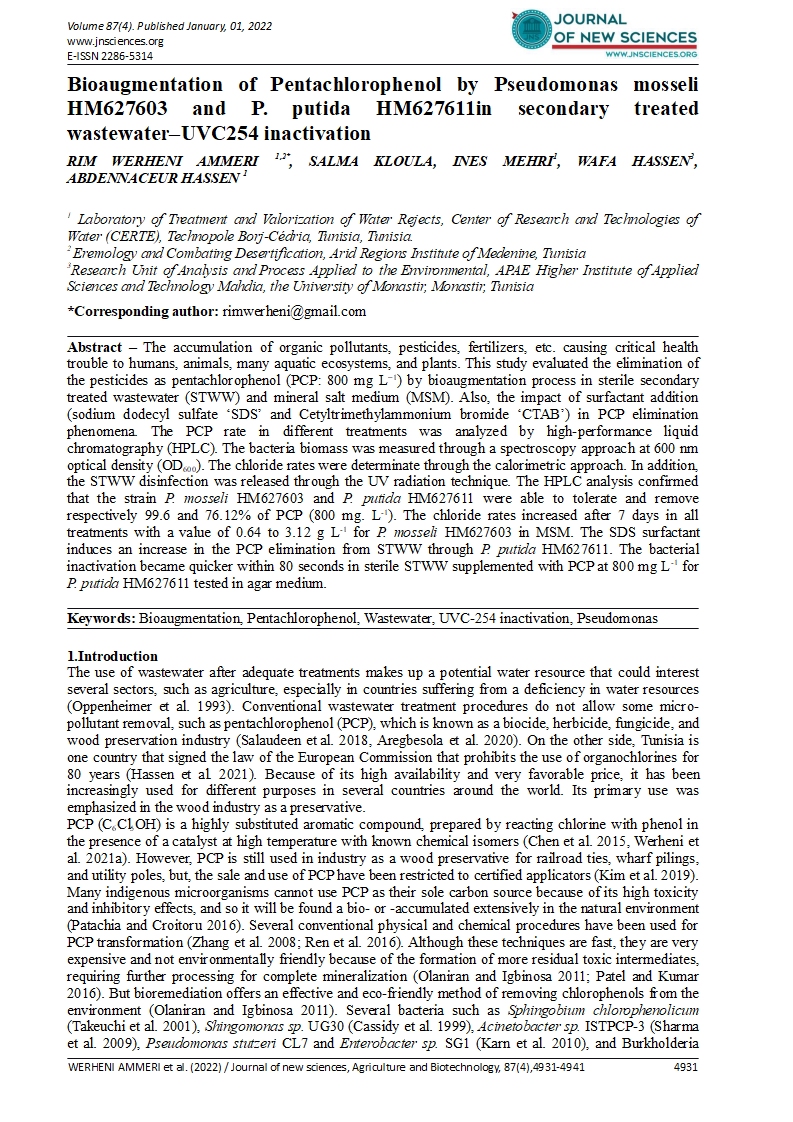

- Category: Volume 87
- Hits: 3757
Bioaugmentation of Pentachlorophenol by Pseudomonas mosseli HM627603 and P. putida HM627611in secondary treated wastewater–UVC254 inactivation
RIM WERHENI AMMERI 1,2
SALMA KLOULA
INES MEHRI1
WAFA HASSEN3
ABDENNACEUR HASSEN 1
1 Laboratory of Treatment and Valorization of Water Rejects, Center of Research and Technologies of Water (CERTE), Technopole Borj-Cédria, Tunisia, Tunisia.
2 Eremology and Combating Desertification, Arid Regions Institute of Medenine, Tunisia
3Research Unit of Analysis and Process Applied to the Environmental, APAE Higher Institute of Applied Sciences and Technology Mahdia, the University of Monastir, Monastir, Tunisia
DOI: https://doi.org/10.55416/sunb.jns01.2201.08704
Abstract – The accumulation of organic pollutants, pesticides, fertilizers, etc. causing critical health trouble to humans, animals, many aquatic ecosystems, and plants. This study evaluated the elimination of the pesticides as pentachlorophenol (PCP: 800 mg L−1) by bioaugmentation process in sterile secondary treated wastewater (STWW) and mineral salt medium (MSM). Also, the impact of surfactant addition (sodium dodecyl sulfate ‘SDS’ and Cetyltrimethylammonium bromide ‘CTAB’) in PCP elimination phenomena. The PCP rate in different treatments was analyzed by high-performance liquid chromatography (HPLC). The bacteria biomass was measured through a spectroscopy approach at 600 nm optical density (OD600). The chloride rates were determinate through the calorimetric approach. In addition, the STWW disinfection was released through the UV radiation technique. The HPLC analysis confirmed that the strain P. mosseli HM627603 and P. putida HM627611 were able to tolerate and remove respectively 99.6 and 76.12% of PCP (800 mg. L-1). The chloride rates increased after 7 days in all treatments with a value of 0.64 to 3.12 g L-1 for P. mosseli HM627603 in MSM. The SDS surfactant induces an increase in the PCP elimination from STWW through P. putida HM627611. The bacterial inactivation became quicker within 80 seconds in sterile STWW supplemented with PCP at 800 mg L-1 for P. putida HM627611 tested in agar medium.
Keywords: Bioaugmentation, Pentachlorophenol, Wastewater, UVC-254 inactivation, Pseudomonas

